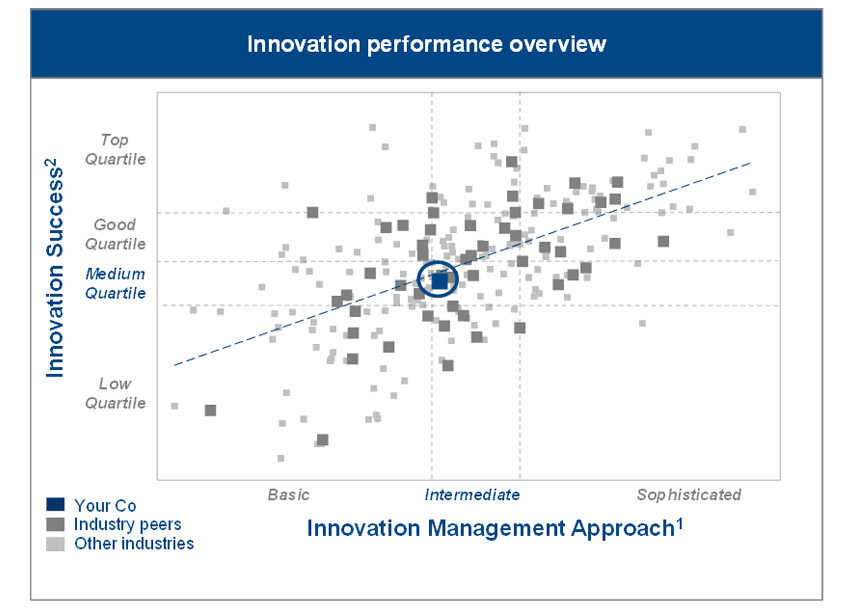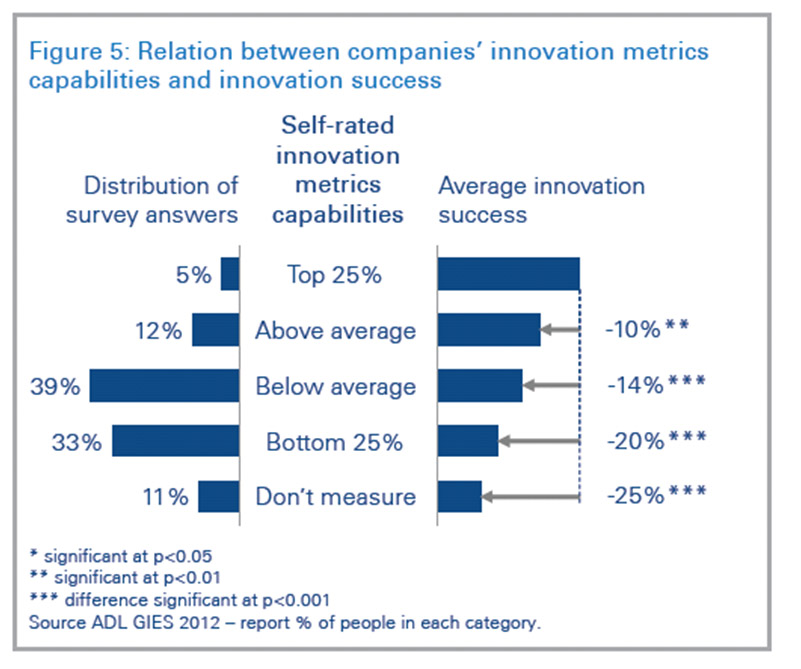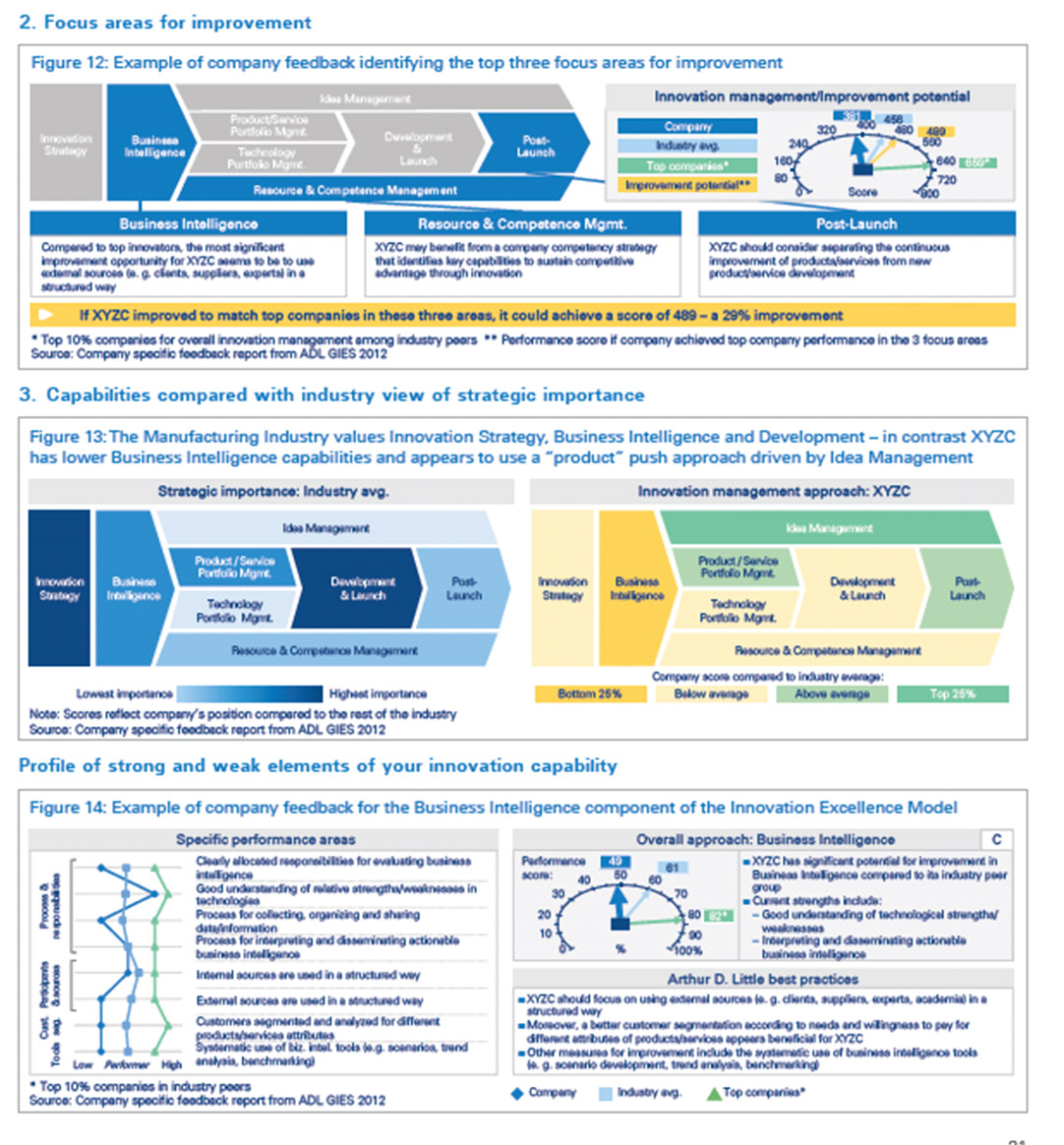So you’re convinced that investing in innovation is a good thing to do but you’re not sure that you are getting good value from your investment. You’ve seen over a dozen articles on innovation in the last year alone – typically these focus on a few iconic examples (such as Apple, eBay, or P&G) – but some of the advice is conflicting and you wonder how applicable it really is to your industry. You might be thinking that some of your innovation management practices need improvement but there seems to be little empirical evidence or reliable benchmarks about what really does and doesn’t work.
Arthur D. Little’s 8th Global Innovation Survey can help you address these problems. We’d like to share some initial findings with you and invite you to benchmark yourself against your industry peers.
Benchmarking the return on your innovation investment
In 2012 Arthur D. Little initiated its 8th global innovation excellence study. Running since the mid 1990s, the survey is aimed at companies that want to understand their performance in terms of innovation management and who want to identify areas for improvement. We collected responses to a structured questionnaire covering over 70 aspects of innovation management best practice (either in PDF or more frequently through an online-survey). In addition a number of feedback interviews were carried out to validate the findings from the analysis.
This version of the study covers a wide range of industries and adjusts for industry characteristics. Uniquely, the survey enables companies not only to benchmark innovation management practices, but also to relate these to innovation success achieved – a composite measure including revenues, profits and process improvements from introduction of innovation. The results are normalised for industry performance based on over 10 years worth of data from current and previous Innovation Excellence Studies covering over 650 companies.
The evidence: Excellence in innovation management leads to greater innovation success
One of the most important and significant findings from our study was that across all industries – despite their huge diversity in terms of products, services, customers and dynamics – there is a strong correlation) between how well companies implement innovation best practices and the innovation success they achieve (see Figure 1 R2=0.33; significant at p<0.001). In other words, adopting the best practices according to Arthur D. Little’s model helps firms to achieve greater innovation success and to understand how they stack up against industry peers and the wider set of study participants.
Top quartile performers achieve 13% more profit and 30% shorter time-to-break-even than average performers
Our analysis confirms that there is considerable scope (and reward) for improving innovation performance. Comparing top quartile performers with the rest of the sample, there is a significant gap of up to 13% points in terms of EBIT from recent product & service introduction, as well as a gap of 30% in terms of average time-to-break-even. However, the gap between the best and worst performers has narrowed in recent years, suggesting that underperformers can and do catch up, and that maintaining a lead in innovation performance is getting ever harder.
Those who measure innovation well also perform well – but few are satisfied
We found a strong and positive correlation between companies’ assessment of their own capabilities in innovation measurement and the innovation success achieved. This underpins the long-accepted maxim supported by our own experience in working with clients, namely “If you can’t measure it you can’t manage it”.
The left hand side of Figure X shows that only 17% of companies rate themselves either in the top quartile or above average in terms of innovation metrics capabilities and points to a high level of dissatisfaction with their efforts to measure innovation performance. The right hand side of Figure 5 shows that with decreasing performance in innovation metrics capabilities, innovation success also decreases significantly (dropping monotonically with each successive drop in quartile). This underlines the inherent difficulty companies have in measuring innovation and the significant potential for companies to improve their capabilities in this area.
Four approaches seem to have a highest impact on innovation success across all industries.
Although top innovators tend to perform significantly better across the areas of ADL’s Innovation Excellence Mode (see below) there are four innovation approaches which are absolutely critical to overall innovation success: two are associated with improving linkages between innovation activities and business goals, and two with leveraging the most important resources to achieve better performance.
The four most significant factors of innovation success are:
- Understanding each technology in terms of its quantified contribution to corporate goals: understanding capability needs from the customer’s perspective; valuing technology on a consistent basis; and explicitly linking technology with Products, Process or changes to the Business Model.
- Using external sources of business intelligence in a structured way: for example lead users, suppliers, external technical experts, creative patent structure analysis, crowd sourcing; Attracting and developing intelligence, instead of relying on finding it
- Reacting to changes in targeted segments by reviewing the product/service portfolio: review and manage their product and service portfolio throughout the lifecycle; clear “phase in/ phase out logic”; robust segmentation model; careful synchronization of product and service planning.
- Mobilizing the whole organization to develop new ideas: not just relying on the Innovation Unit or R&D for new ideas; consistently applied process to enrich, select, park and kill ideas; incentives and rewards; structures and environments to promote creativity and collaboration
It is perhaps surprising that many companies still do not implement these basic practices effectively. In contrast, many tools which are often referenced in innovation literature, such as Idea Jams, Bootcamps and social networking tools, are not as widely used in innovation management as may have been expected, and their contribution to performance is less significant at present.
The Innovation Excellence Framework Model provides a valuable best practice reference
In formulating these and many other insights, the survey has made reference to Arthur D. Little’s Innovation Excellence Model. The Model provides a structure to understand the different components of the innovation management system, divided into 5 upstream components (making the right strategic choice i.e. “doing the right things” and 3 downstream components (activities needed to deliver results i.e. “doing things right”)
Upstream
- Innovation Strategy: Corporate strategic & innovation priorities
- Business Intelligence: Tools and techniques used to identify, extract and analyze business data
- Idea Management: Process to generate ideas for new products/services
- Product/Service Portfolio Management: Prioritizing creation, enhancement or termination of an offering, process or product feature
- Technology Portfolio Management: Prioritizing research and technology investments to be able to access required technologies
Downstream
- Development and Launch: All steps required to transform the original idea to a launched product/ service/process
- Post Launch: Product upgrading and continuous improvement
- Resource & Competence Management: Managing your internal and external capabilities
The framework as originally introduced in 1995 based on Arthur D. Little’s consulting experience in the area of Technology and Innovation Management and early versions of it were discussed in some of ADL’s publications like Product Juggernauts (insert author reference) and has been gradually tested and refined through extensive casework with ADL’s leading clients in the area of technology management over the last two decades.
As part of the Survey process, companies score how well they perform in innovation management versus each of the each of the 8 components of the model – a total of more than 70 best practice elements – as well as the level of innovation success they have achieved, a composite measure including revenues, profits and process improvements from introduction of innovation. The Survey takes account of differences in practices between different industries, and enables benchmarking versus industry peers.
What you can get from participating in the Survey
All participants receive a tailored benchmarking report rating their performance against both industry peers and the entire sample set – this presents an overview of innovation performance but also allows each company to understand what practices it could adopt to achieve maximum impact on innovation performance within its industry. The analysis builds on data from well over 600 companies (see example of feedback below).
Companies who have received feedback have found it to be extremely valuable.
The main report provides further background on these and many other important insights – we hope you will enjoy the content.
About the authors
 Anders Johannson is ADL’s global practice leader for Technology and Innovation Management. Based in ADL Sweden he has over 20 years of experience within Technology and Innovation Management, both within ADL and in senior industry positions. Anders has a MSc in Chemical Engineering from Chalmers University of Technology and an MBA fromGothenburg University.
Anders Johannson is ADL’s global practice leader for Technology and Innovation Management. Based in ADL Sweden he has over 20 years of experience within Technology and Innovation Management, both within ADL and in senior industry positions. Anders has a MSc in Chemical Engineering from Chalmers University of Technology and an MBA fromGothenburg University.
 Ben Thuriaux- Alemán is a Principal in ADL UK with 17 years of consulting experience. He works both with Energy clients and on more general issues in the area of R&D, Technology and Innovation Management. Ben has an MBA from RSM and Chicago GSB, a MSc in Science and Technology Policy, and a BSc in Physics.
Ben Thuriaux- Alemán is a Principal in ADL UK with 17 years of consulting experience. He works both with Energy clients and on more general issues in the area of R&D, Technology and Innovation Management. Ben has an MBA from RSM and Chicago GSB, a MSc in Science and Technology Policy, and a BSc in Physics.
 Rick Eagar is a partner in the ADL UK where he leads the Technology and Innovation Management Practice. He has over 23 years consulting experience in R&D, technology and innovation management and 10 years in industry. He has a BSc in Mechanical Engineering from the University of Bristol and is chief editor of Arthur D. Little’s management journal Prism.
Rick Eagar is a partner in the ADL UK where he leads the Technology and Innovation Management Practice. He has over 23 years consulting experience in R&D, technology and innovation management and 10 years in industry. He has a BSc in Mechanical Engineering from the University of Bristol and is chief editor of Arthur D. Little’s management journal Prism.










